With New Funding, Future Looks Bright for Austin’s Art in Public Places
By Pamela Hall Vance
Reporting Texas
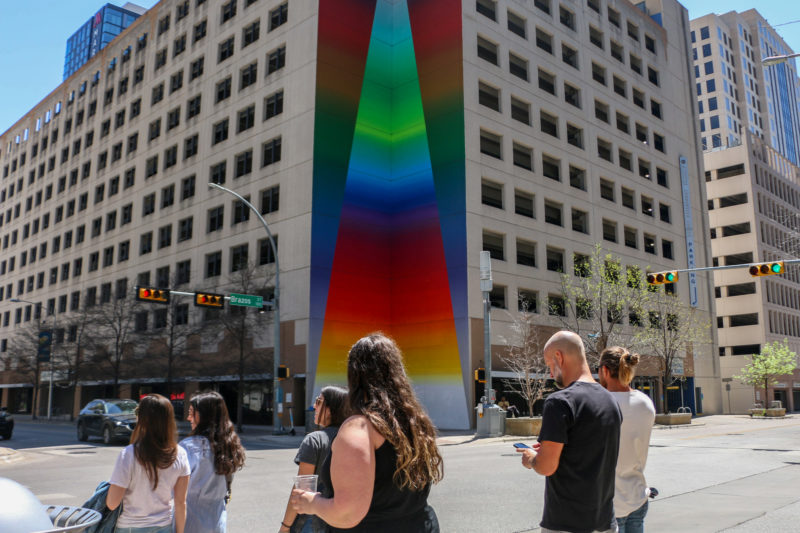
People cross the street in front of Tau Ceti, a mural in downtown Austin on March 30, 2022. Clarissa Abrego/Reporting Texas
On a Monday evening in February, Ausitnite Karen Cross, 52, was taking a post-dinner walk near Tau Ceti, one of the newer public art installations in Austin.
“So I was walking. And I was like, I gotta go back to that, because all of a sudden, now the clouds are awesome,” she said, as she stood on the corner of Brazos and Second streets taking pictures. “I love the prism and the colors themselves are incredible”.
According to Hannah Green, the concierge at the hotel across the street, Tau Ceti is a hot spot for both locals and tourists. It is the tallest of the more than 325 art pieces in the archive of the City of Austin. Eight more public art projects soon will be added to the collection after the city announced $700,000 in additional funding, paid for by construction projects.
About 40% of that money will go toward artwork at a new health facility and two parks that are undergoing renovation. Marjorie Flanagan, Austin Art in Public Places acting program manager, and Anna Bradley, the program’s senior project manager, outlined the four artwork opportunities and submission requirements in two information sessions last month. Applications for all the projects were due in March.
Artists in AIPP’s Pre-Qualified Artist Pool will receive the remaining 60% of the funds for four projects that include artwork for new and renovated aquatics facilities and a road improvement project.
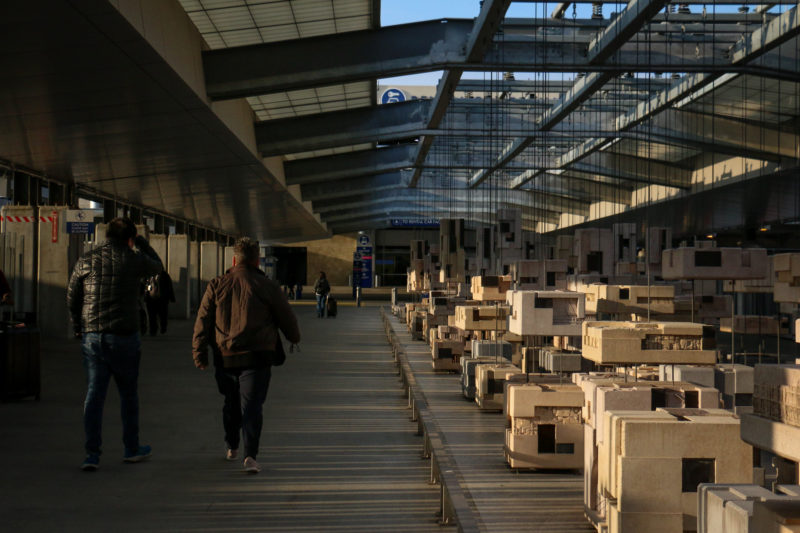
People walk next to the 2015 artwork “Uplifted Ground” at Austin-Bergstrom International Airport on March 11, 2022. The piece, part of the Art in Public Places Collection of the City of Austin, features suspended elements made of cast concrete and granite, which were inspired by local geological formations, native minerals and aerial photography. Clarissa Abrego/Reporting Texas
The City of Austin promotes itself as the first municipality in Texas to commit to include works of art in its budget. Through a 1985 citizen initiative, 1% of city construction project spending was set aside for the commission or purchase of art; that percentage has since been doubled.
“It was really a push from community members to make that commitment to arts and culture,” Flanagan said: “The way that our ordinance is written, 2% of a capital improvement project comes down to our program, and the artwork … must be located in, at or near the facility that’s getting the improvement. So, the funding is really tied to the facility that’s getting the improvement.”
Community involvement through focus groups helps set goals to guide the artists working on each project. AIPP requires that the artists engage with the community as part of their contracts. Flanigan says that there has been a trend over the past five to eight years for more inclusivity and that they want to provide public art that resonates with those who live and work around it
Patricia Walsh, director of creative community advancement at Americans for the Arts, said that there can be problems if communities don’t feel that they have been engaged enough or are not aware of what’s going on. However, Austin has a good track record. Walsh says she appreciates how the city and artists try to engage community through their work.
“People like to see how they’re reflected in their built environments. And so, a lot of public art allows for that,” Walsh said. “It allows for people to explore histories and cultures that they may not be aware of.”
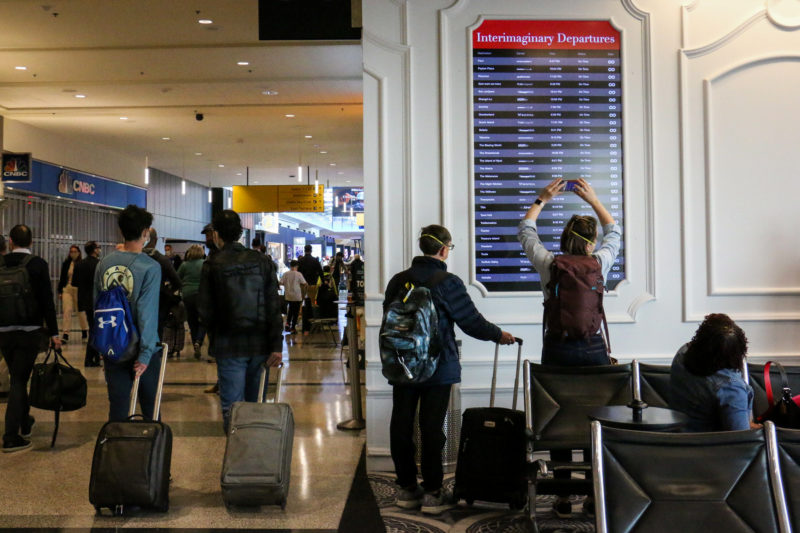
Airline passengers take photos of the departure times listed in the public art installation “Interimaginary Departures” at Austin-Bergstrom International Airport on March 11, 2022. Clarissa Abrego/Reporting Texas
An AIPP exhibit at the Austin-Bergstrom International Airport adds a layer of imagination to that exploration. Between gates 12 and 14 is an “infinity gate” with its own ticketing window and destinations to fictional locations like Wakanda and Hogwarts.
“Attention Passengers enroute to Atlantis. We are sorry to tell you that your flight and all subsequent flights to Atlantis have been cancelled,” says the announcer. He further explains that due to a single night of misfortune, the island has disappeared into the depths of the sea and ends with “Have a nice day.”
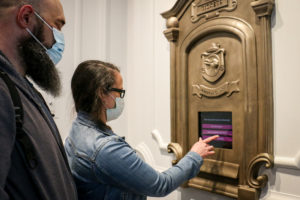
Daisy and Michael De Simone acquire a ticket from the interactive ticketing window at the “Interimaginary Departures” exhibit. Clarissa Abrego/Reporting Texas
If one looks closely at the stack of books on the 2021 display, the title of the exhibit, “Interimaginary Departures” and its artist, Janet Zweig, are listed. Cory Hurless, the art program manager at the airport, says she gets many positive responses about the exhibit.
Public art is considered an investment by the City of Austin because it contributes to the city in several ways. Not only through the economic component from the jobs created but also from the impact of the arts to help bridge diverse cultures and improve the quality of life. Not all communities feel that way. San Antonio residents recently debated whether to cut the 1.5% of spending being set aside for public art from a proposed $1.2 billion bond package.
In addition to commissions, the City of Austin also manages donations, which is how statues of Stevie Ray Vaughan, Willie Nelson and Barbara Jordan came under AIPP care. The city program handles maintenance and insurance not only for the statues and all of the artwork in its 35-year-old collection, some of which is starting to show some wear and tear.
“Because of the way that the laws are written surrounding bond dollars, we can’t use them towards the maintenance of the collection,” Flanagan said. They have been able to set aside some funding, but she acknowledges that it’s a challenge that many many art programs face.
Other challenges are bringing about lasting change to the city’s commitment of institutionalizing equity in their practices. “In the same way that the rest of the country is facing staffing challenges, we are too,” said Flanagan. They are working to get the money out to support artists as fast as possible.
Austin artists can look forward to plenty of opportunities to showcase their art to the public. Bonds approved by Austin voters in 2016 and 2018 will provide additional funding for the AAIPP program through construction projects for several arts and cultural centers in Austin. In addition, the airport has a variety of upcoming construction projects that will generate funding for public art.
“There will be more art coming,” Hurless said. “It will keep me employed and busy until I drop dead I guess, or retire.”
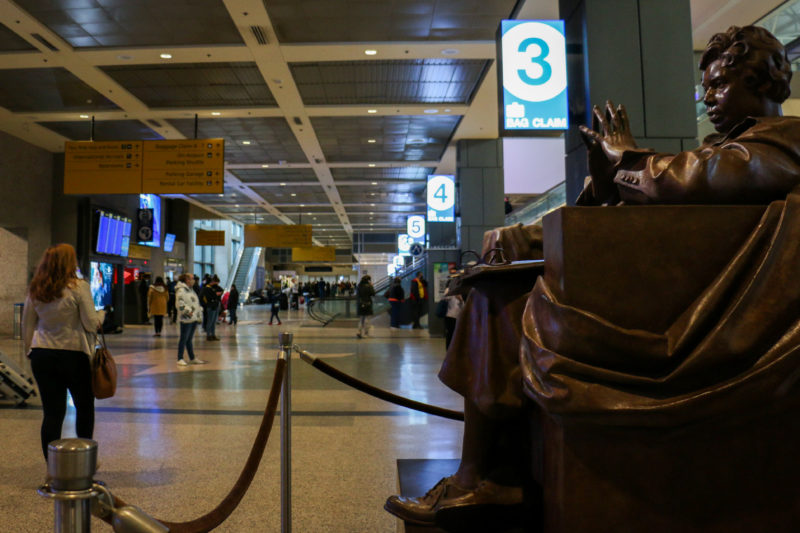
People walk next to the “Barbara Jordan Memorial Statue” at Austin-Bergstrom International Airport on March 11, 2022. Clarissa Abrego/Reporting Texas